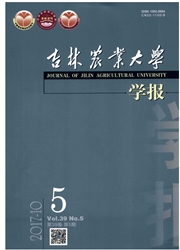

 中文摘要:
中文摘要:
以人参6种病原真菌及其6种拮抗细菌和4种拮抗放线菌为受体,研究了新林土、三年生人参根际土壤、撂荒10年老参地土甲醇提取物对其生长的影响。结果表明:人参根际土壤提取物对病原真菌生长的影响存在抑制和促进2种类型,对拮抗细菌、拮抗放线菌的影响表现为抑制;对受体真菌、细菌、放线菌的影响存在明显的种间差异;综合比较抑制作用强弱顺序为拮抗细菌〉拮抗放线菌〉病原真菌。新林土中本身存在着影响受体微生物生长的物质组分,栽培人参后,该组分活性增强,表明人参根际土壤中物质和组成的变化与人参病原真菌、拮抗细菌、拮抗放线菌的生长具有一定的相关性。
 英文摘要:
英文摘要:
The effects of the methanol extracts of new forest soil, three-year ginseng rhizosphere soil and ginseng-grown land soil resting for ten years on growth of six kinds of ginseng pathogenic fungi, six kinds of antagonistic bacterias and four kinds of antagonistic actinomycetes were studied. The results showed that: The methanol extracts of ginseng rhizosphere soil presents inhibitory effect, or promoting effect occasionally on ginseng pathogenic fungi, while only presenting inhibitory effect on antagonistic bacteria and actinomycetes. The inhibitory and promoting effects were obviously different between test microbial species. The inhibitory effects fell into the following sequence: antagonistic bacterias〉 antagonistic actinomycetes〉 pathogenic fungi. Some chemical components were present in new forest soil affecting the growth of receptors. Once ginsengs being planted, the activity of the chemicals in soil increased. The growth of ginseng pathogenic fungi, antagonistic bacterias and actinomycetes was evidently affected by change of some chemical substances and their composition inginseng rhizosphere soil.
 同期刊论文项目
同期刊论文项目
 同项目期刊论文
同项目期刊论文
 期刊信息
期刊信息
